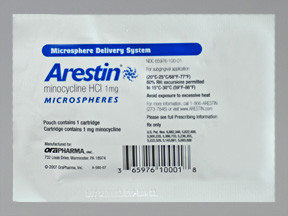MINOCYCLINE - DENTAL
PHONETIC PRONUNCIATION: (MIN-oh-SYE-kleen)
COMMON BRAND NAME(S): Arestin
GENERIC NAME(S): minocycline HCl microspheres
Uses
USES: This medication is used to treat adult gum disease (periodontitis). Minocycline belongs to a class of drugs known as tetracycline antibiotics. It works by preventing the growth of bacteria. This medication is a powder that your dental professional places into infected tooth pockets. Minocycline is then slowly released over the next several weeks.
How to use MINOCYCLINE - DENTAL
HOW TO USE: The dental professional will prepare each dose before placing this product into the infected tooth pocket(s). The dosage is based on your medical condition and response to treatment. After this medication is placed in your tooth pocket(s), do not touch any treated areas for 7 days. Avoid using treated teeth to chew, and do not eat hard, crunchy, or chewy foods for 7 days. Do not floss or clean between teeth treated with the medicine for 10 days after treatment. Follow your dentist's directions carefully. Your dental professional may apply a second treatment with this product. Keep all of your dental appointments while using this medication. Tell your dentist if your condition lasts or gets worse.
Side Effects
Precautions
Interactions
Overdose
Images
Reviews
Faq for MINOCYCLINE - DENTAL
Minocycline is an antibiotic commonly used in the field of dentistry. It belongs to the tetracycline class of antibiotics and is effective in treating various dental infections.
Minocycline works by inhibiting the growth and spread of bacteria that cause dental infections. It does this by blocking the synthesis of proteins needed by the bacteria to survive.
Minocycline is commonly used to treat periodontal infections, such as gum disease and periodontitis. It may also be prescribed for dental abscesses, periapical infections, and other oral infections.
Minocycline is typically taken orally, in the form of capsules or tablets. It is important to follow the dosage and frequency instructions provided by your dentist or healthcare professional. It is usually recommended to take the medication with a full glass of water, and it should be taken at least one hour before or two hours after consuming dairy products or antacids, as these may interfere with its absorption.
Common side effects of Minocycline include nausea, vomiting, dizziness, headache, and diarrhea. It may also cause changes in skin color or pigmentation, especially in areas exposed to sunlight. Less commonly, it can lead to allergic reactions, yeast infections, or liver problems. If you experience any severe or persistent side effects, it is important to seek medical attention.
Minocycline should not be taken by pregnant women or children under the age of 8, as it can cause permanent tooth discoloration and affect bone development. It is also important to inform your dentist or healthcare professional about any pre-existing medical conditions or medications you are taking, as these may interact with Minocycline.
The effectiveness of Minocycline varies depending on the specific dental condition being treated. In most cases, improvement should be noticeable within a few days of starting the medication. However, it is important to complete the full course of treatment as prescribed, even if symptoms improve, to ensure complete eradication of the infection.
Minocycline is commonly used in dentistry for the treatment of gum infections, periodontitis, and other dental infections.
Minocycline belongs to a class of antibiotics called tetracyclines. It works by inhibiting the growth of bacteria that cause dental infections, reducing inflammation, and promoting the healing process.
Common side effects of minocycline include nausea, vomiting, diarrhea, dizziness, and skin sensitivity to sunlight. It is important to inform your dentist if you experience any unusual side effects.
Minocycline is not typically prescribed for dental prophylaxis or routine dental cleanings. It is usually prescribed for the treatment of active infections.
The effectiveness of minocycline in treating dental infections can vary depending on the severity of the infection. However, improvement is usually seen within a few days of starting treatment.
Minocycline is generally not recommended for use during pregnancy or breastfeeding. It may have adverse effects on the developing fetus or infant. Consult with your dentist or healthcare provider for alternative treatment options.
Minocycline can interact with other medications, such as birth control pills, certain antibiotics, and blood thinners. Inform your dentist or healthcare provider about all the medications you are taking to avoid potential interactions.
Minocycline is usually taken orally in the form of capsules or tablets. It is important to follow the specific instructions provided by your dentist or healthcare provider for the correct dosage and duration of treatment.
Minocycline is often prescribed for the treatment of tooth abscesses, as it helps to eliminate the infection and reduce swelling and pain. However, the dentist will assess your situation and determine the most appropriate treatment plan.
Disclaimer
IMPORTANT: HOW TO USE THIS INFORMATION: This is a summary and does NOT have all possible information about this product. This information does not assure that this product is safe, effective, or appropriate for you. This information is not individual medical advice and does not substitute for the advice of your health care professional. Always ask your health care professional for complete information about this product and your specific health needs.

No Reviews Yet